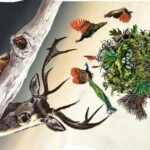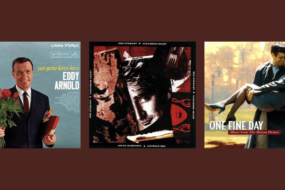
In American songs and folk tales, a crossroads is where you meet the devil at midnight — where you make a choice. It’s a potent metaphor despite its ubiquity, which is no doubt why the Smithsonian chose “Crossroads: Change in Rural America” as the title of an exhibition that is traveling through towns in Vermont and New Hampshire. The show recently opened at the Chandler Center for the Arts in Randolph, where it’s on view through March 22.
The exhibition, developed by the Smithsonian and copresented by Vermont Humanities and New Hampshire Humanities, is itself a kind of crossroads where two very different curatorial approaches intersect. One path, in the center of the gallery, is a series of six freestanding exhibition walls organized around five themes: identity, land, community, persistence and managing change. The other path is a selection of works by Vermont artists, hung around the edges of the gallery and organized by Rebbie Carleton and the Chandler’s volunteer gallery committee.
The Smithsonian’s panels try to define “rural America” and present examples of how it has changed over the past century, with a look toward current and future challenges. The institution’s offerings include historical photos, objects, video, sound, little binders for viewers to flip through and an interactive touch screen, along with quite a bit of curatorial text.
A viewer can, and should, get lost in the details. The section on identity features fascinating and culturally inclusive historical photos of farmers and rural people. On panels and in video slideshows, viewers can see Dorothea Lange’s famous images of farmworkers in the 1930s and ’40s, formal portraits such as the upstanding-looking “Natsumeda family, California, 1927,” and snapshots of people in rural communities taken in the past decade. A subtitled video displays people’s definitions of what “rural” means to them.
A section of reproduced historical paintings, including Grant Wood’s “American Gothic” and Thomas Cole’s “Notch of the White Mountains,” points out how artists have often romanticized rural life. But this part of the exhibit misses the mark in some respects. The paintings lose their impact at such a small scale. The display doesn’t mention that many of these artists were lamenting the loss of rural or wild landscapes even as they depicted them, bestowing a purposefully elegiac quality on their scenes.
The presentation does best when it illustrates its points with specific examples. In a section about land, it describes how Indigenous territory was “sometimes surrendered under pressure or sometimes purchased,” accompanied by an image of an 1805 treaty ceding lands from five different Indigenous nations to the U.S. Through photos and text, the panel traces how part of that land in Indiana was later settled by a white family. With the added context, an old legal document becomes compelling. It’s an effective way to use one small story to acknowledge a much larger history.
In sections on contemporary rural revitalization, the exhibit details small-town projects such as arts hubs and farmers markets. The Clemmons Family Farm in Charlotte is offered as one example of an organization connecting culture with agriculture.
The exhibition’s broad strokes, however, seem a bit out of place. Assertions such as “Rural Americans contribute to the nation’s economic and cultural wealth with their knowledge, hard work, and creativity” feel a bit patronizing. Much of the text led this reviewer to wonder for whom the exhibition is intended.
Viewers will see a more nuanced and creative approach to rural identity in the excellent local additions to the show. Among them, Linda Diak’s 8-by-6-foot quilt, “Road Trip,” stands out. It depicts a motley crew of a bull, a pig, an emu and a peacock driving a convertible, the wind in their feathers. Diak constructed the image with detailed, precise appliqué, quilted through with swirling, cloudlike lines and geometric patterns.
Funny and bold, the piece is made poignant by the description on its label of how these animals were lost during the 2023 floods. The bull and pig were found within a day, while the emu was on the run for a month. “Kevin, the peacock, has not been seen since,” reads the label. “We hope he is somewhere living his best life.”
Carolyn Egeli presents several large, exquisitely painted and ornately framed canvases. “The Stink Eye” captures a cow setting down a hoof by the edge of a creek. “Collecting Sap” shows local farmers sugaring with a horse-drawn wagon. Either could be mistaken for a view from a century ago, but their labels offer contemporary context. The cow is part of a herd sold off due to cost pressures; the sugar maker’s wife is described as an environmental attorney for the state, a nod to the fact that many farmers have to work other jobs to make ends meet.
Photographer Jack Rowell offers varied and personality-laden black-and-white images of rural Vermonters. They include his grizzled “Man on the Midway” at the 1972 Tunbridge World’s Fair as well as expressive portraits of Randolph resident Margaret Egerton — pictured as a fiesty almost-100-year-old — and a 2014 portrait of Brookfield-raised singer-songwriter Myra Flynn, looking young and hopeful. Their specificity, and their differences, signal deeper individual stories of people who are not solely defined by their country settings.
Steve DePalma turns his camera to rural structures. He documented every covered bridge in Vermont, then edited his photos into abstract, kaleidoscopic images whose diamond shapes and crisscrossing patterns mirror the bridges’ timbers. Looking at these iconic symbols of the rural landscape in such a new way illustrates a creative openness to change that’s not always apparent in the exhibition’s more documentary images.
Several of the works speak to the balance between change and constancy. Davey Mace’s hooked rug “Things of the Heart” echoes a Currier and Ives print reproduced elsewhere in the exhibition, with toddlers riding plastic toys swapped in for the 19th-century horse-drawn sleigh. That kind of revision places us in the present while reinforcing how little the landscape has changed.
Several of Woody Jackson’s paintings, with stark black-and-white cows against vibrant fields of magenta and lime, radiate the crisp energy of the rural landscape and articulate its appeal more effectively than anything the Smithsonian has on view.
Both Jennifer Davey, with ecologically themed hooked rugs, and Cecily Anderson, with digital illustrations of farmers, address climate change — a glaring omission in the Smithsonian’s exhibition — as a force driving massive change and prompting hard choices.
While visitors may already have a pretty clear idea of why rural communities matter, it is absolutely worth seeing them through our neighbors’ eyes and through the conflicts and challenges of the past century. The exhibition is a capsule of a very particular moment in time, one we may have just passed: when the U.S. government articulated diversity, inclusion and awareness of history as national strengths, as the curators do here. See it while you still can; as the exhibition text says, “Change, good or bad, is inevitable.”












